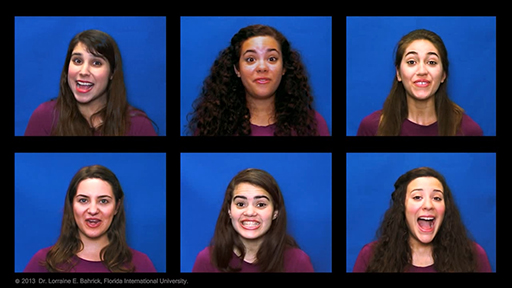- Home
- Research
Research
Intersensory Processing Efficiency Protocol (IPEP)

Multisensory Attention Assessment Protocol (MAAP)

Overall Goals
The purpose of our studies is to gain a better understanding of how infants learn to perceive, categorize, and remember the objects and events in their environment and how these early developing skills lead to more complex social, cognitive, and language skills in childhood. In a world that provides constantly changing stimulation to all of our senses, how do infants determine which sights and sounds belong together and constitute unitary events (i.e., intersensory processing)? And how do they learn to attend to stimulation that is relevant to their needs and actions and ignore the vast array of stimulation that is irrelevant? Our primary goal is to understand how attention, perception and learning develop across the first years of life in typical development and thus to provide insight into how these processes go awry in atypical development such as autism. We have developed the first tests to assess individual differences in attention and intersensory processing skills for infants and young children of both typical and atypical development. Our research contributes to the construction of theories about early development as well as to our understanding and early identification of atypical developmental processes.
For more detailed information about our research, see our Publications.
For more detailed information about our current studies, see our MultiNet Project and Developmental Trajectories Project pages.
Research Findings
Faces, voices, and the sounds of speech are arguably the most important, prevalent, and salient forms of stimulation encountered by infants. Our research, supported by The National Institutes of Health and the National Science Foundation, has investigated the auditory, visual, and intersensory processes that promote heightened attention and perceptual expertise for faces, voices, and speech in young infants. Our research has shown that by three to six months of age, infants can detect rhythm, tempo, and face-voice synchrony during speech. They can discriminate male from female faces and adult from child faces, and know which voices and faces belong together. Infants can also remember the relationship between a particular face and its respective voice, can match their own face with their own vocalizations, and can recognize their own face and distinguish it from that of another baby. Memory for everyday actions (such as brushing teeth, or blowing bubbles) is long lasting, and persists across months. Our future goals are to investigate the nature, basis, and developmental course of infants’ attention to social and object events and to understand how attention to these events provides a foundation for later cognitive, social and language skills. Children with autism typically show impairments in attention and social interaction. We have developed two new fine-grained measures of attention and intersensory processing for infants and young children of both typical and atypical development, the Multisensory Attention Assessment Protocol (MAAP), and the Intersensory Processing Efficiency Protocol (IPEP). Results from our studies indicate that relative to children of typical development, children with autism are impaired in shifting and maintaining attention to faces and voices, particularly in the face of competing stimulation from other concurrent events. In contrast, they appear less impaired when attending to object events. We are currently testing typically developing infants and young children using these measures to characterize the typical development of attention and intersensory perception of face and object events. This will allow us to determine which children fall outside the range of typical development and are at risk for developmental delays.
Research in the Infant Development Lab is supported by grants from the National Institutes of Health.
NICHD Intersensory Processing, Developmental Trajectories, and Longitudinal Outcomes (R01 HD053776). Florida International University, 2006- 2024.
NICHD Multisensory Development: New Measures and a Collaborative Database (RO1 HD094803). Florida International University, 2019-2024.
Our research has been supported by: 



